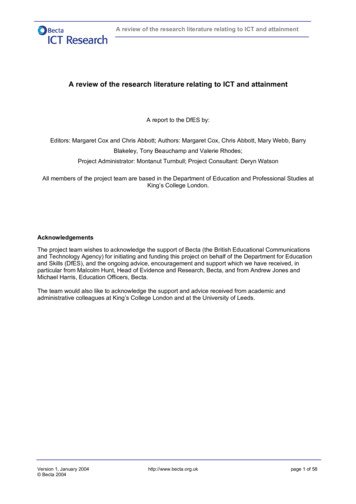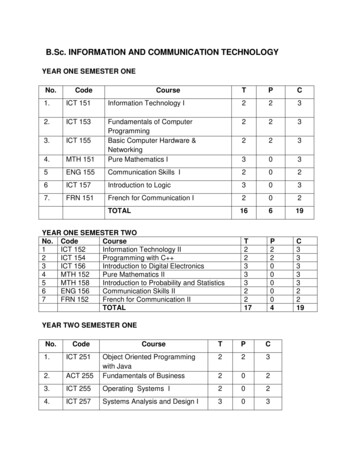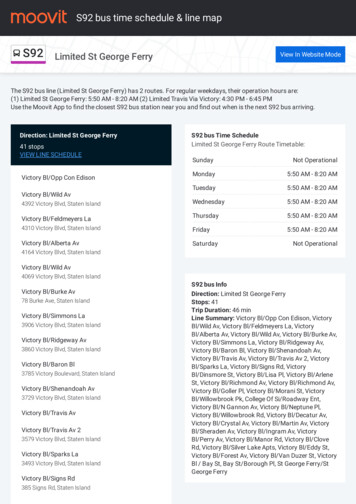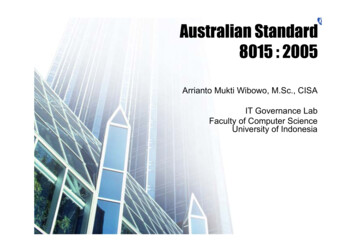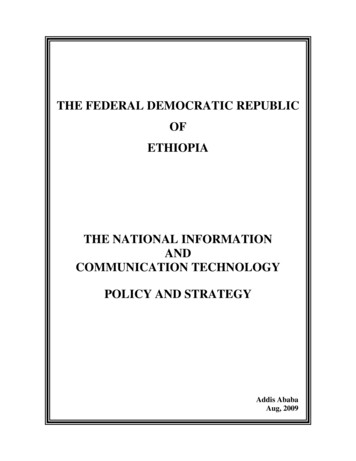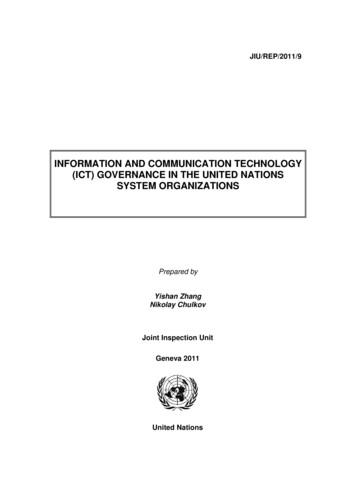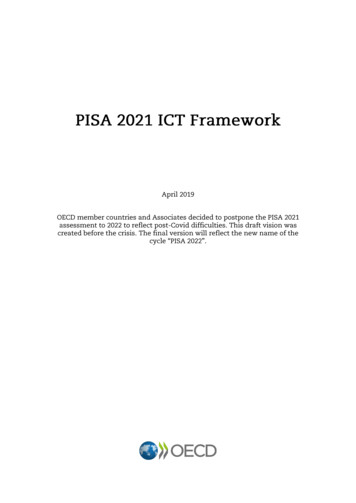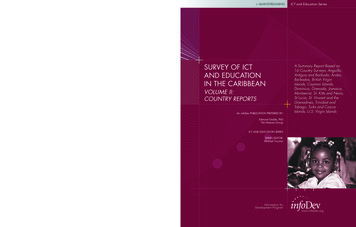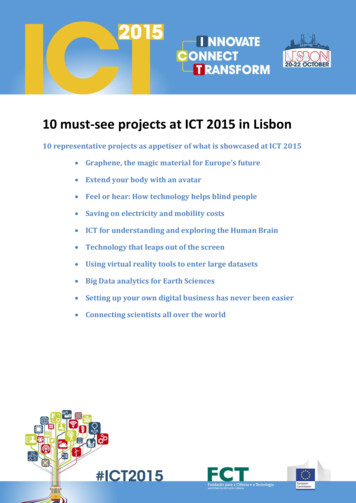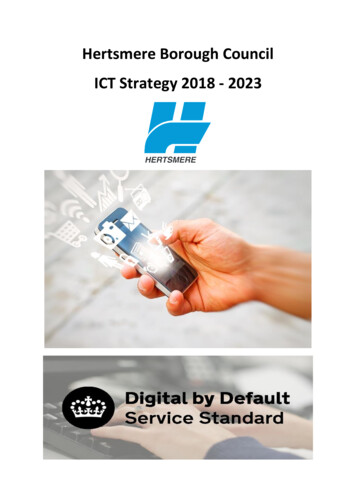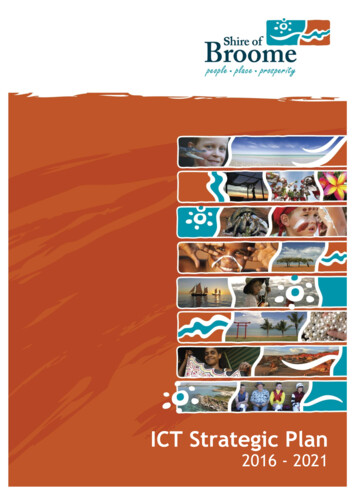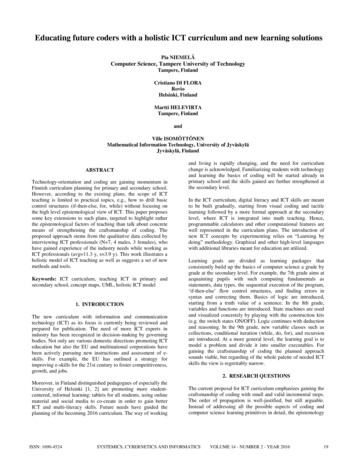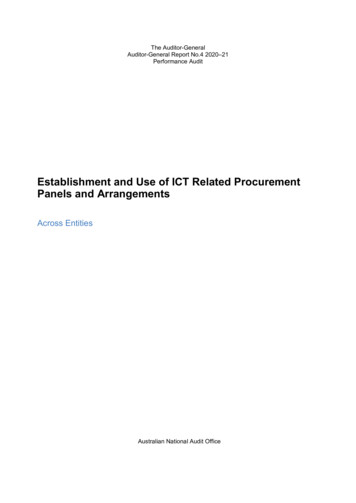
Transcription
The Auditor-GeneralAuditor-General Report No.4 2020–21Performance AuditEstablishment and Use of ICT Related ProcurementPanels and ArrangementsAcross EntitiesAustralian National Audit Office
Commonwealth of Australia 2020ISSN 1036–7632 (Print)ISSN 2203–0352 (Online)ISBN 978-1-76033-573-1 (Print)ISBN 978-1-76033-574-8 (Online)Except for the content in this document supplied by third parties, the Australian NationalAudit Office logo, the Commonwealth Coat of Arms, and any material protected by a trademark, this document is licensed by the Australian National Audit Office for use under theterms of a Creative Commons Attribution-NonCommercial-NoDerivatives 3.0 Australia licence.To view a copy of this licence, visit u/.You are free to copy and communicate the document in its current form for non-commercialpurposes, as long as you attribute the document to the Australian National Audit Office andabide by the other licence terms. You may not alter or adapt the work in any way.Permission to use material for which the copyright is owned by a third party must be soughtfrom the relevant copyright owner. As far as practicable, such material will be clearly labelled.For terms of use of the Commonwealth Coat of Arms, visit the It’s an Honour website uests and inquiries concerning reproduction and rights should be addressed to:Senior Executive DirectorCorporate Management GroupAustralian National Audit OfficeGPO Box 707Canberra ACT 2601Or via email:communication@anao.gov.au.Auditor-General Report No.4 2020–21Establishment and Use of ICT Related Procurement Panels and Arrangements2
Canberra ACT31 August 2020Dear Mr PresidentDear Mr SpeakerIn accordance with the authority contained in the Auditor-General Act 1997, I haveundertaken an independent performance audit across entities titled Establishment andUse of ICT Related Procurement Panels and Arrangements. I present the report of thisaudit to the Parliament.Following its presentation and receipt, the report will be placed on the Australian NationalAudit Office’s website — http://www.anao.gov.au.Yours sincerelyGrant HehirAuditor-GeneralThe Honourable the President of the SenateThe Honourable the Speaker of the House of RepresentativesParliament HouseCanberra ACTAuditor-General Report No.4 2020–21Establishment and Use of ICT Related Procurement Panels and Arrangements3
AUDITING FOR AUSTRALIAThe Auditor-General is head of theAustralian National Audit Office(ANAO). The ANAO assists theAuditor-General to carry out hisduties under the Auditor-GeneralAct 1997 to undertakeperformance audits, financialstatement audits and assurancereviews of Commonwealth publicsector bodies and to provideindependent reports and advicefor the Parliament, the AustralianGovernment and the community.The aim is to improveCommonwealth public sectoradministration and accountability.For further information contact:Australian National Audit OfficeGPO Box 707Canberra ACT 2601Phone: (02) 6203 7300Email: ag1@anao.gov.auAuditor-General reports andinformation about the ANAO areavailable on our website:http://www.anao.gov.auAudit teamGrace GuilfoyleElizabeth WedgwoodJames SheeranAshton Barrington-KnightMichelle PageAuditor-General Report No.4 2020–21Establishment and Use of ICT Related Procurement Panels and Arrangements4
ContentsSummary and recommendations. 7Background . 7Conclusion . 9Supporting findings . 10Recommendations . 13Summary of entities’ responses . 14Key messages from this audit for all Australian Government entities .17Audit findings. 191. Background . 20Introduction . 20Legislative and policy framework applicable to procurement . 21Previous audits . 23Rationale for undertaking the audit . 23Audit approach . 242. Establishment of ICT related procurement panels and arrangements — procurement planningand evaluation of suppliers . 26Did the planning, determination of procurement method and approach to market for the selectedarrangements comply with the CPRs and related guidance? . 28Did the evaluation of suppliers and value for money consideration for the selected arrangementscomply with the CPRs and related guidance? . 383. Establishment of ICT related procurement panels and arrangements — approval, reporting, riskmanagement, probity and monitoring arrangements . 52Did approvals, records and AusTender reporting for the selected arrangements comply with thePGPA Act, CPRs and related guidance? . 52Did the management of risk and probity for the selected arrangements comply with the CPRsand related guidance? . 55Did Infrastructure and DTA establish monitoring arrangements to enable them to assess whetherthe selected procurement arrangements met their objectives? .604. Use of ICT related procurement panels and arrangements . 68Did the planning, determination of procurement method and approach to market for the selectedprocurements comply with the CPRs and related guidance? . 71Did the evaluation of suppliers and value for money consideration for the selected procurementscomply with the CPRs and related guidance? . 88Did approvals, records and AusTender reporting for the selected procurements comply with thePGPA Act and CPRs and related guidance? . 95Did the management of risk and probity for the selected procurements comply with the CPRsand related guidance? . 100Appendices . 105Appendix 1Appendix 2Appendix 3Entity responses . 106Number of opportunities on the Digital Marketplace by the number of sellers invitedto respond . 116Examples of price information available to buyers using the Digital Marketplace .120Auditor-General Report No.4 2020–21Establishment and Use of ICT Related Procurement Panels and Arrangements5
Auditor-General Report No.4 2020–21Establishment and Use of ICT Related Procurement Panels andArrangements In 2018-19 Australian governmentexpenditure on ICT related goods andservices was over 3.9 billion. The use ofprocurement panels and arrangements isintended to achieve efficiency and reducerisk, while supporting the achievement ofvalue for money. Previous audits haveidentified shortcomings with respect tosome entities' application of theCommonwealth Procurement Rules(CPRs). Three procurement arrangements wereexamined in this audit: the IT Servicespanel, the Digital Marketplace panel andthe IBM Whole of Australian GovernmentArrangement.The combined reported value ofcontracts under the arrangements is over 2.8 billion.The audit examined the establishment ofthese arrangements and seven entities’use of the three arrangements. In establishing the three selected ICTrelated procurement panels andarrangements, Infrastructure and DTAcould not fully demonstrate that thearrangements supported the achievementof value for money outcomes.In their use of the 15 selected ICT relatedprocurement panels and arrangements,entities could demonstrate that themajority of procurements supported theachievement of value for moneyoutcomes, however in three cases it wasdifficult for entities to demonstrate thisdue to the absence of competition.When using such arrangements, entitiesneed to adopt processes that are not justtechnically compliant with the CPRs butare also consistent with their intent, whichis to drive value for money throughcompetition.The Auditor-General made fourrecommendations aimed at improvingcompliance with the CPRs and ensuringofficials have sufficient understanding ofprocurement requirements.
Summary and recommendationsBackground1.Procurement is the process of acquiring goods and services.1 It is integral to the conductof Australian Government activity and a core function of the Commonwealth public sector. In2018–19 there were 78,150 contracts published on AusTender2 with a combined value of 64.5 billion.3 Contracts in the Information Technology Broadcasting and Telecommunicationscategory accounted for 6.1 per cent of the total value of reported contracts, representing over 3.9 billion.4 Auditor-General Report No. 27 2019–20 Australian Government ProcurementContract Reporting Update reported that the number and value of panel contracts reported eachyear has increased significantly over the last ten years. In 2018–19, more than 36 per cent ofreported contracts, involving over 17 per cent of reported contract values, were identified ashaving been drawn from a panel.5Cooperative and coordinated procurements, including panel arrangements2.‘Cooperative’ procurement is the use of a procurement contract by more than one entity.Department of Finance (Finance) guidance states that cooperative procurement ‘enables entitiesto reduce expenditure by sharing administration costs and utilising their combined economies ofscale’.63.Finance guidance states that ‘coordinated’ procurement arrangements are typicallyestablished for commonly used goods or services to increase efficiency, reduce cost, enhanceservice and quality and provide increased transparency, standard terms and conditions andimproved contract management that benefits both the government and suppliers.74.Cooperative and coordinated procurements generally result in an overarching contract,agreement or standing offer arrangement. A standing offer arrangement is often referred to as a1234567Department of Finance (Finance), Commonwealth Procurement Rules, 20 April 2019, paragraph 2.7, [Internet],Finance, available from 9-11/CPRs-20-April-2019 1.pdf[accessed June 2020].AusTender is the Australian Government’s procurement information system. It provides a central web-basedfacility for publishing Australian Government business opportunities and annual procurement plans andreporting contracts and standing offers awarded with a value of 10,000 or more. Contract values shown onAusTender are a reflection of contract commitment, not actual expenditure.Finance, Statistics on Australian Government Procurement Contracts—Total Procurement Contracts [Internet],Finance, available from cts [accessed June 2020].Finance, Statistics on Australian Government Procurement Contracts—2018–19 Procurement Contracts: Top20 Categories for Goods and Services [Internet].Auditor-General Report No.27 2019–20 Australian Government Procurement Contract Reporting Update,pp.34–5, [Internet], ANAO, available from 2019 [accessed June 2020].Finance, Cooperative Agency Procurement, [Internet], Finance, available yprocurement [accessed June 2020].Finance, Whole of Australian Government Procurement, [Internet], Finance, available ed June 2020].Auditor-General Report No.4 2020–21Establishment and Use of ICT Related Procurement Panels and Arrangements7
panel arrangement. Finance defines a panel arrangement as ‘a tool for the procurement of goodsor services regularly acquired by entities’.8 Typically under a panel arrangement, multiplesuppliers are appointed and each supplier is able to provide goods or services to an entity.Rationale for undertaking the audit5.The use of cooperative and coordinated procurement arrangements, which can includepanel arrangements, is intended to achieve efficiency and reduce risk, while supporting entitiesto achieve value for money outcomes. Previous ANAO audits have identified shortcomings withrespect to some entities’ application of the Commonwealth Procurement Rules (CPRs), includingpanel arrangements.9 Given the large number of procurements undertaken and the centrality ofprocurement to the operation of government and program delivery, entities’ procurementpractices should be efficient, effective, ethical and economical and suited to the size andcomplexity of the goods or services sought.Audit objective, criteria and scope6.The objective of the audit was to assess the extent to which entities’ establishment anduse of ICT related procurement panels and arrangements supported the achievement of value formoney outcomes.7.To form a conclusion against the objective, the audit examined whether entities compliedwith the Commonwealth Procurement Rules (CPRs) and followed related guidance10 when: establishing ICT related procurement panels and arrangements; and using ICT related procurement panels and arrangements.8.The audit assessed selected components of the establishment and use of two ICT relatedcooperative procurement panels: the IT Services panel established by the Department of Infrastructure, Transport, RegionalDevelopment and Communications (Infrastructure); and the Digital Marketplace panel established by the Digital Transformation Agency (DTA).9.The audit also examined the establishment and use of the IBM Whole of AustralianGovernment Arrangement (IBM Arrangement) managed by the DTA.10.Use of the panels and IBM Arrangement was examined at Infrastructure, DTA and thefollowing Commonwealth entities: 8910Australian Electoral Commission;Finance, Panel Arrangements [Internet], Finance, available s[accessed June 2020].The CPRs establish the procurement framework for the Commonwealth public sector. In general, previousaudits have found that some entities needed to employ more competitive procurement processes, betterdocument value for money assessments, obtain appropriate approvals and improve reporting on AusTender.See for example: Auditor-General Report No.48 2014–15 Limited Tender Procurement; Auditor-GeneralReport No. 54 2013–14 Establishment and Use of Multi-Use Lists; and Auditor-General Report No.31 2011–12Establishment and Use of Procurement Panels. [Internet], ANAO, available fromhttps://www.anao.gov.au/pubs/performance-audit [accessed June 2020].Related guidance is guidance outlined in the CPRs and other guidance provided by Finance.Auditor-General Report No.4 2020–21Establishment and Use of ICT Related Procurement Panels and Arrangements8
Summary and recommendations Australian Taxation Office; Department of Home Affairs; Department of Industry, Science, Energy and Resources; and Services Australia.11.The ANAO examined a sample of 15 procurements — five from each of the two panelsexamined and five procurements made under the IBM Arrangement.12.The audit also examined whether Infrastructure and DTA established effective monitoringarrangements to enable them to assess whether the panels or arrangements met their objectives.13.During the course of the audit, the ANAO was advised by the Department of Finance ofallegations of fraud related to the supply of information technology contractors. At the time ofpublishing this report investigations are ongoing.Conclusion14.In establishing the three selected ICT related procurement panels and arrangements,Infrastructure and DTA could not fully demonstrate that the arrangements supported theachievement of value for money outcomes. In their use of the 15 selected ICT relatedprocurement panels and arrangements, entities could demonstrate that the majority ofprocurements supported value for money outcomes, however in three cases it was difficult forentities to demonstrate this due to the absence of competition.15.In relation to the establishment of the selected arrangements: Infrastructure complied with the CPRs and adopted related guidance when establishing itspanel but could have adopted a more robust approach to the consideration of price,quality and risk to better support the achievement of a value for money outcome. DTA did not comply with the all of the CPRs but did adopt a number of sound practicesoutlined in Finance guidance when establishing the Digital Marketplace panel. Itsapproach did not support the achievement of a value for money outcome or treatsuppliers equitably. Once DTA identified these deficiencies it changed its processes. DTA’snew approach complies with the minimum requirements of the CPRs, although DTA’sconsideration of price, quality and risk could be more robust to better demonstrate thatits evaluation of suppliers achieves value for money outcomes. In establishing the IBM Whole of Australian Government Arrangement (IBM Arrangement)DTA largely complied with the requirements of the CPRs and the approach adopted anumber of sound practices outlined in Finance guidance and supported the achievementof a value for money outcome. As the IBM Arrangement was only conducted with onesupplier, the approach supported the achievement of a value for money outcome in thecircumstances. Infrastructure and DTA obtained relevant approvals and complied with CPR reportingrequirements. Given the scale and scope of its procurement arrangements, DTA shouldhave been more active in identifying and managing key risks and probity arrangements inthe establishment process.Auditor-General Report No.4 2020–21Establishment and Use of ICT Related Procurement Panels and Arrangements9
Infrastructure did not conduct systematic monitoring to assess whether its panelarrangement was meeting its objectives. The panel ceased operation in February 2020.DTA conducts a range of monitoring activities in relation to the Digital Marketplace paneland the IBM Arrangement. Monitoring indicates the Digital Marketplace panel objectivesare largely being met and the IBM Arrangement is achieving some of its objectivesalthough anticipated savings have not yet been achieved.1116.In relation to the use of the selected arrangements, entities largely complied with the CPRsto support the achievement of a value for money outcome. For one procurement, documentationdid not fully demonstrate that the conditions for limited tender were met. In two otherprocurements, there was limited evidence supporting value for money considerations. In thesethree cases it was difficult for entities to demonstrate that the procurements achieved a value formoney outcome. There were instances of entities not meeting requirements regarding theapproval of variations to contracts, record keeping and AusTender reporting. There was alsoscope for some entities to strengthen their consideration and management of risk and probity.17.When procuring from panels the CPRs remove the requirement for procurements over therelevant threshold to be offered to the wider market. This occurs whether or not the arrangementprovides buyers with sufficient information to be an effective substitute for going to the widermarket. The ability to achieve value for money for individual procurements from a panel istherefore impacted by the robustness of the processes used to assess suppliers when establishingthe panel. For example, where a panel includes suppliers with low technical ability or high risk, orbuyers cannot use price to help select the suppliers to approach, it is difficult to obtain a highdegree of assurance that value for money has been appropriately assessed and achieved. It is alsodifficult to obtain such assurance when entities only approach one or a small number of suppliers.Procurements from panels and similar arrangements are often perceived as requiring less timeand effort to conduct, particularly when the cost and time involved in running an open approachto market is considered, or when engaging a new supplier. When using panels and similararrangements, entities need to adopt processes that are not just technically compliant with theCPRs but are also consistent with their intent, which is to drive value for money throughcompetition.Supporting findingsEstablishment of ICT related procurement panels and arrangements —procurement planning and evaluation of suppliersPlanning, determination of procurement method and approach to market18.Infrastructure’s planning and approach to market for the establishment of the IT Servicespanel complied with the CPRs and demonstrated adoption of key sound practices identified inFinance guidance. Infrastructure documented reasons for establishing the panel and approachedthe market to conduct an open tender, which encouraged competition from the outset to supportthe achievement of a value for money outcome. Had Infrastructure established strongerthresholds in terms of price, quality and risk and included details in the request documentation,11In July 2020 DTA advised the ANAO that planned savings have been delayed but are anticipated to be met.Auditor-General Report No.4 2020–21Establishment and Use of ICT Related Procurement Panels and Arrangements10
Summary and recommendationsit would have been in a position to undertake a more robust assessment of value for money atthe evaluation stage.19.DTA’s planning and approach to market for the establishment of its Digital Marketplacepanel did not comply with all of the CPR requirements but did demonstrate the adoption of anumber of key sound practices identified in Finance guidance. The planning and approach tomarket did not support the achievement of a value for money outcome. DTA documented clearobjectives for establishing the panel and approached the market to conduct an open tender whichencouraged competition. However, DTA’s request documentation did not require suppliers toprovide price information and DTA was therefore unable to conduct a value for moneyassessment in accordance with CPR requirements. Additionally, suppliers were able to join thepanel based on different requirements — this resulted in not all suppliers being treated equitably,which is inconsistent with the CPRs.20.DTA’s planning and approach to market for the establishment of the IBM Arrangementcomplied with the CPRs and demonstrated adoption of key sound practices identified in Financeguidance. DTA documented clear objectives for establishing the arrangement and approachedIBM via a limited tender as part of a coordinated approach to expand the number of Whole ofAustralian Government (WoAG) arrangements in place.Evaluation of suppliers and value for money consideration21.Infrastructure’s evaluation of suppliers and consideration of value for money whenestablishing the IT Services panel complied with the CPRs. Had Infrastructure established strongthresholds in terms of price, quality and risk the department would have been able to undertakea more robust assessment of value for money.22.DTA appointed sellers to the Digital Marketplace panel without a value for moneyassessment and suppliers were admitted based on different requirements — decisions which arenot consistent with the CPRs. DTA identified that the panel had been established incorrectly andconducted a ‘value for money (VFM) refresh’ exercise. From 1 July 2018 existing and prospectivesuppliers have been required to provide one price for each of the categories applied for as wellas technical information, which has enabled DTA to undertake a value for money assessment ofsuppliers. While DTA’s new process is sufficient to achieve compliance with the minimumrequirements of the CPRs, its consideration of price, quality and risk could be more robust tobetter demonstrate that its evaluation of suppliers supports the achievement of value for moneyoutcomes.23.In establishing the IBM Arrangement, DTA’s evaluation approach complied with the CPRsand demonstrated adoption of key sound practices to support the achievement of a value formoney outcome. Establishing the IBM Arrangement involved detailed contractual negotiationswith both IBM and affected Commonwealth entities. Each entity involved in the negotiationsreviewed the proposed terms and prices relevant to them and engaged with DTA to assist informing the Australian Government negotiating position.Auditor-General Report No.4 2020–21Establishment and Use of ICT Related Procurement Panels and Arrangements11
Establishment of ICT related procurement panels and arrangements — approval,reporting, risk management, probity and monitoring arrangementsApprovals, records and AusTender reporting24.Infrastructure and DTA obtained relevant approvals for each of the three selectedarrangements. Infrastructure and DTA also complied with the CPRs when reporting details ofthese arrangements on AusTender.Management of risk and probity25.When establishing the selected arrangements Infrastructure and DTA establishedprocesses to manage risk and probity. Given the scale and scope of the procurements, DTA shouldhave been more active in identifying and managing key risks for the Digital Marketplace panel andIBM Arrangement, and developed more robust probity arrangements for both arrangements.Monitoring arrangements26.Infrastructure did not conduct systematic monitoring to assess whether the panelobjectives were met. The panel ceased operation in February 2020. DTA undertakes a range ofmonitoring activities in relation to the Digital Marketplace panel. Monitoring indicates that itsobjectives are largely being met. DTA’s role in establishing and monitoring the ongoing use of theIBM Arrangement enabled it to ascertain that the arrangement is largely meeting its objectives.As the planned timeframe for establishing the IBM Arrangement was not achieved, plannedsavings have also not been achieved. As at June 2020, DTA was working with Finance to finalisearrangements for achieving anticipated savings from the IBM Arrangement.Use of ICT related procurement panels and arrangementsPlanning, determination of procurement method and approach to market27.For the sample of 15 procurements reviewed by the ANAO there were seven whereentities had not met the requirement in the CPRs to estimate the value of the procurement priorto determining the procurement approach. In all seven cases this did not impact the selection orreporting of the procurement method — the operation of the CPRs means that theseprocurements are automatically required to be reported on AusTender as employing the sameprocurement method used to establish the initial arrangement, regardless of the value of theprocurement.28.All entities documented the objective of the procurement and the goods or servicesprocured were within the scope of the respective arrangement. For one limited tenderprocurement with IBM, ATO documentation did not fully demonstrate that the conditions forlimited tender were met. Request documentation was prepared for nine of the 10 procurements.The documentation conveyed the key requirements of the procurement and included evaluationcriteria that would enable the entity to assess the financial and non-financial benefits of theprocurement to achieve a value for money outcome.Evaluation of suppliers and value for money consideration29.Fourteen of the 15 procurements reviewed by the ANAO documented the evaluation ofsuppliers and consideration of value for money to meet the minimum requirements of the CPR
intended to achieve efficiency and reduc e risk, while supporting the achievement of value for money. Previous audits have identified shortcomings with respect to some entities' application of th e Commonwealth Procurement Rules (CPRs). In establishing the three selected ICT related procurement panels and arrangements, Infrastructure and DT A
